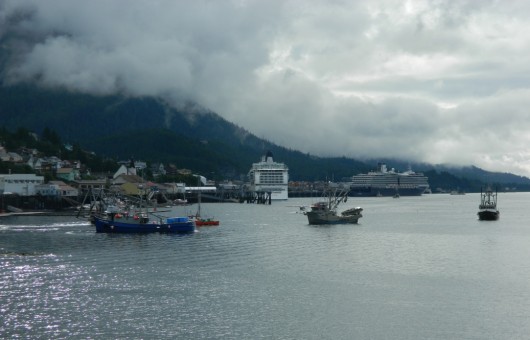Way back in April, the City of Ketchikan hired the private nonprofit agency Historic Ketchikan to develop a master plan for the 1.3-mile downtown waterfront promenade.
“We feel like this stretch of public waterfront is extremely unique,” said Stephen Reeve, executive director of Historic Ketchikan. “We’ve visited a lot of other successful waterfront areas and ours is one of the best, I think, in the world, potentially.”
Reeve and Historic Ketchikan board member Terry Wanzer presented the study’s findings to the Ketchikan City Council. Reeve briefly described the process.
“We talked a lot with property owners, with interest groups, with individuals who are interested in the waterfront and we’ve kind of come up for the moment with a set of principles that are directing us in our work,” he said.
One of those principles is that, although the promenade originally was conceived as a way to help disperse summertime cruise ship visitors throughout the downtown area, it still should be useful for residents, throughout all the seasons.
“We need to make sure everyone in the community has access, people of all ages, we need to make it possible for older people, as well as families and younger people to enjoy it,” Reeve said. “And we need to recognize that we’re not going to do this overnight.”
Reeve said the plan is a vision that the community can strive toward through a series of projects over the next few decades. The vision includes using natural boardwalk, incorporating art, providing covered performance space, and installing informational signs about Ketchikan’s past and present.
STATE’S DESIGN COMMENTS DELAYED
Later in the meeting, the Council decided to delay action on a motion calling for the city to submit comments on a draft design for completion of the waterfront promenade. Council members directed city staff to forward the state’s plan to Historic Ketchikan’s board for input.
The promenade has been partially done for a few years, but the final section has been on hold. The Alaska Department of Transportation is now accepting comments on the design, and plans to bid the project this fall, with construction starting in winter or this coming spring.
One concern raised at the Council meeting was the Stedman Street bridge, which is part of the promenade’s route, and whether the design would provide better space for fishing, to reduce hazardous interactions between pedestrians and fishing hooks.
Mayor Lew Williams III and City Manager Karl Amylon talked a little about how to address that concern.
“The only way I could see it, other than if we could move them down to the dock on the right and the floats on the left out on Thomas Basin, or putting a fish cleaning thing in between the sidewalk and the bridge somehow,” Williams said.
Amylon agreed. He also noted that completion of the promenade likely will add to summertime congestion along Stedman Street, so the city might need to eventually add seasonal traffic control officers.
FIGHT CLUB GETS COUNCIL NOD
The Council on Thursday also voted 4-2 to approve a revised agreement with the Ketchikan Fight Club, allowing that organization to continue staging its events at the Ted Ferry Civic Center.
Council Members Dick Coose and Bob Sivertsen voted no, citing concern over allowing the nonprofit to sell alcohol with its own permit, rather than contracting that service.
CONSOLIDATION OR UNIFICATION?
The city’s sometimes contentious relationship with the Ketchikan Gateway Borough also came up during the Council comments portion of the meeting. Council Member DeAnn Karlson said the idea of combining the two has re-emerged.
“It’s verging on the point of being embarrassing for our community as a whole, the way the governments are not able to work in harmony,” she said. “So, it’s not consolidation, it’s unification.”
Mayor Williams reminded the Council that, whether it’s called unification or consolidation, Ketchikan voters have repeatedly rejected attempts to merge the city and borough governments.
The most recent attempt was rejected in 2006.






